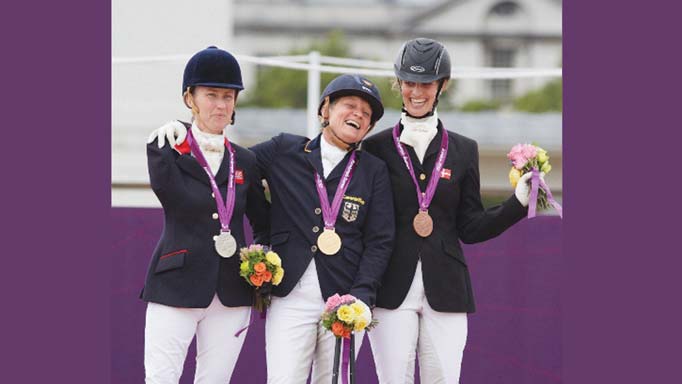Where it all began
Therapeutic riding must be given credit as the ancestor of para-equestrian sport. Danish rider and polio victim Lis Hartel first shed light on riders with disabilities when she won two Olympic silver medals (Helsinki 1952 and Stockholm 1956) despite being unable to walk without crutches. She later started Europe’s first therapeutic riding center. The North American Riding for the Handicapped Association, founded in 1969, promoted safe therapeutic horseback riding in the United States and Canada and now has 3,500 certified instructors helping disabled riders in 800 centres around the world.
Organizers of therapeutic riding programs saw an increase in keen participants and the need to challenge them more, and accordingly the first para-equestrian dressage competitions took place in the 1970s in Europe. At the 1984 Summer Paralympics in Long Island, NY, para-equestrian was included in the form of walk-trot dressage and obstacle courses. The first World Para-Dressage Championships were held in Sweden in 1987. Para-equestrian again was part of the 1996 Paralympics in Atlanta, GA, and continues to be the only equestrian discipline that is included in the Paralympic Games. The International Paralympic Committee recognized para-equestrian in 1991, and by 2006, para-dressage was recognized by the FEI as well. HRH Princess Haya, president of the FEI, was instrumental in having para-dressage included in the World Equestrian Games for the first time in 2010.
From its humble beginnings, para-dressage has grown steadily. At the 2012 London Olympics, 78 athletes competed; at the upcoming WEG it is projected that there will be 96 riders on teams and another 10 national federations sending from one to four individuals. The FEI currently lists over 600 active para-equestrians.
The grading system
Recognizing that the wide variety of challenges faced by disabled riders has differing impacts on their riding abilities, riders are classified into one of five grades to ensure the fairest possible competition playing field. Grade 1a represents the most impaired, while Grade IV represents the least impaired.
Grade Ia (walk only test) and Ib (walk and trot test): Mainly wheelchair users with poor trunk balance and/or impairment of function in all four limbs, or no trunk balance and good upper limb function (e.g. cerebral palsy or spinal cord injury).
Grade II: Mainly wheelchair users or those with severe physical disability involving the trunk and with mild to good upper limb function, or severe unilateral impairment (incl. cerebral palsy, spinal cord injury, and amputees).
Grade III: Mainly able to walk without support, with moderate unilateral impairment, moderate impairment in four limbs or severe arm impairment. Might require a wheelchair for longer distances or due to lack of stamina (incl. cerebral palsy, spinal cord injury, amputees and totally blind riders).
Grade IV: Impairment in one or two limbs (incl. cerebral palsy, spinal cord injury, and amputees) or some degree of visual impairment.
Rider classification must be performed by a qualified physiotherapist or physician. During the status exam, a rider’s locomotor impairment, joint range, muscle strength, balance, coordination, and hearing or visual impairment is assessed to determine an appropriate grade. Some conditions that are not eligible for para-equestrian sports include obesity, psychiatric conditions, skin diseases, epilepsy, fibromyalgia, and general wear and tear due to aging. Riders with disabilities such as multiple sclerosis, which improves and deteriorates over time, may be tested every six months.
Grades I-III compete in a 20-by-40-metre dressage arena, while Grade IV athletes compete in a standard 20-by-60-metre arena. The team competition must include one Ia, Ib, or II rider and cannot be made up of more than three riders of any one grade. The best three scores are combined for a total score. For individual medals, riders compete in a championship and a freestyle class within their grade.

